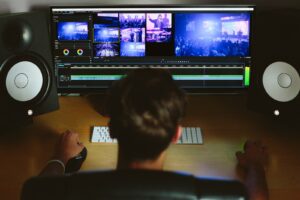Over the past few years, studio monitors (or headphones as they’re often called) have become increasingly popular among musicians and audio professionals of all levels. Not only are they a great way to get a good sound in your recording or performance space, but they’re also affordable and portable enough to take with you on the go.
What are studio monitors and what do they do?
Studio monitors are used in recording studios and other audio-related businesses to produce high-quality sound.
Studio monitors are different from headphones in that they have a wider frequency range, which makes them better suited for producing accurate sound. They are also built to last longer and be more reliable than headphones.
Some of the best studio monitors available on the market include the Mackie HR4H and the Yamaha P-240. These monitors have a great sound quality and are very affordable.
Types of studio monitors
There are two main types of studio monitors: active and passive. Active studio monitors are the type that need to be plugged into a power supply and will emit sound when turned on. Passive studio monitors do not require a power supply, and instead rely on the audio signal from your speakers to produce sound.
The type of monitor you choose will depend on your music production needs. If you are tracking live audio, an active monitor will provide better clarity than a passive monitor. However, if you are mainly producing in the mixing or mastering stage, a passive monitor will give you more accurate sound because it doesn’t amplify the audio signal.
What to look for in a good studio monitor
When it comes to studio monitors, there are a few things you need to take into account. First, you want a monitor that is comfortable to use. Second, you want a monitor that has good sound quality. Third, you want a monitor that is affordable.
Here are some key features to look for when choosing a studio monitor:
-Comfortable to use: Ideally, the chair should be adjustable and have a height range of between 6 and 12 inches.
-Good sound quality: Make sure the monitor has a good sound quality rating from an independent testing organization like Audioholics.com. This will ensure that the audio coming out of the monitor is of high quality.
-Affordable: Don’t overspend on a studio monitor if you don’t have to. A good budget range for studio monitors is $200 – $500.
How to buy a studio monitor
When it comes to studio monitors, there are a lot of different options available. To make the best choice, you first need to know what you’re looking for.
The first thing to consider is your budget. Do you want a small, cheap monitor that will do the job, or do you want something that will sound good and be reliable?
Next, think about your needs. What type of music do you work with the most? Do you want a monitor that can handle loud noises or one that’s more suited for acoustic music?
After you’ve decided on your budget and needs, it’s time to choose a model. There are tons of different studio monitors available on the market, so it can be tough to decide which one is right for you.
There are several factors to consider when choosing a studio monitor: sound quality, features, size, and weight. Ultimately, the best option for you will depend on your specific needs and preferences. So don’t be scared to try out a few different models before making a purchase!
How to set up a studio monitor
Studio monitors are important for any musician who wants to get the best sound possible. Here are some tips on how to set up a studio monitor correctly.
First, it is important to choose the right type of monitor for your needs. There are three main types of studio monitors: speakers, headphones, and mixers. Each has its own advantages and disadvantages, so it is important to choose the one that will work best for your situation.
Speakers are the most common type of monitor and are the size of a refrigerator. They’re great for large rooms and can handle a lot of volume. However, they can be difficult to move around, so they’re not ideal if you need to move your studio frequently.
Headphones are a good option if you want to keep your studio discreet. They’re also smaller than speakers, which makes them easier to transport. However, they don’t produce as much sound as speakers do and they may not be loud enough for larger rooms.
Mixers are the perfect option if you want both high sound quality and portability. They’re also one of the most affordable options, making them a good choice if you need several monitors. Mixers have multiple channels that can be
Conclusion
In this article, we are going to review the best studio monitors under 1000 dollars. We will cover what to look for in a monitor, as well as giving you our top five picks for the best monitors under $1000. Whether you are a beginner or an experienced musician/audio engineer, I believe that reading this article will help you make an informed decision when it comes to choosing the perfect monitor for your needs. So read on and let us guide you through the selection process!

Leave a Reply